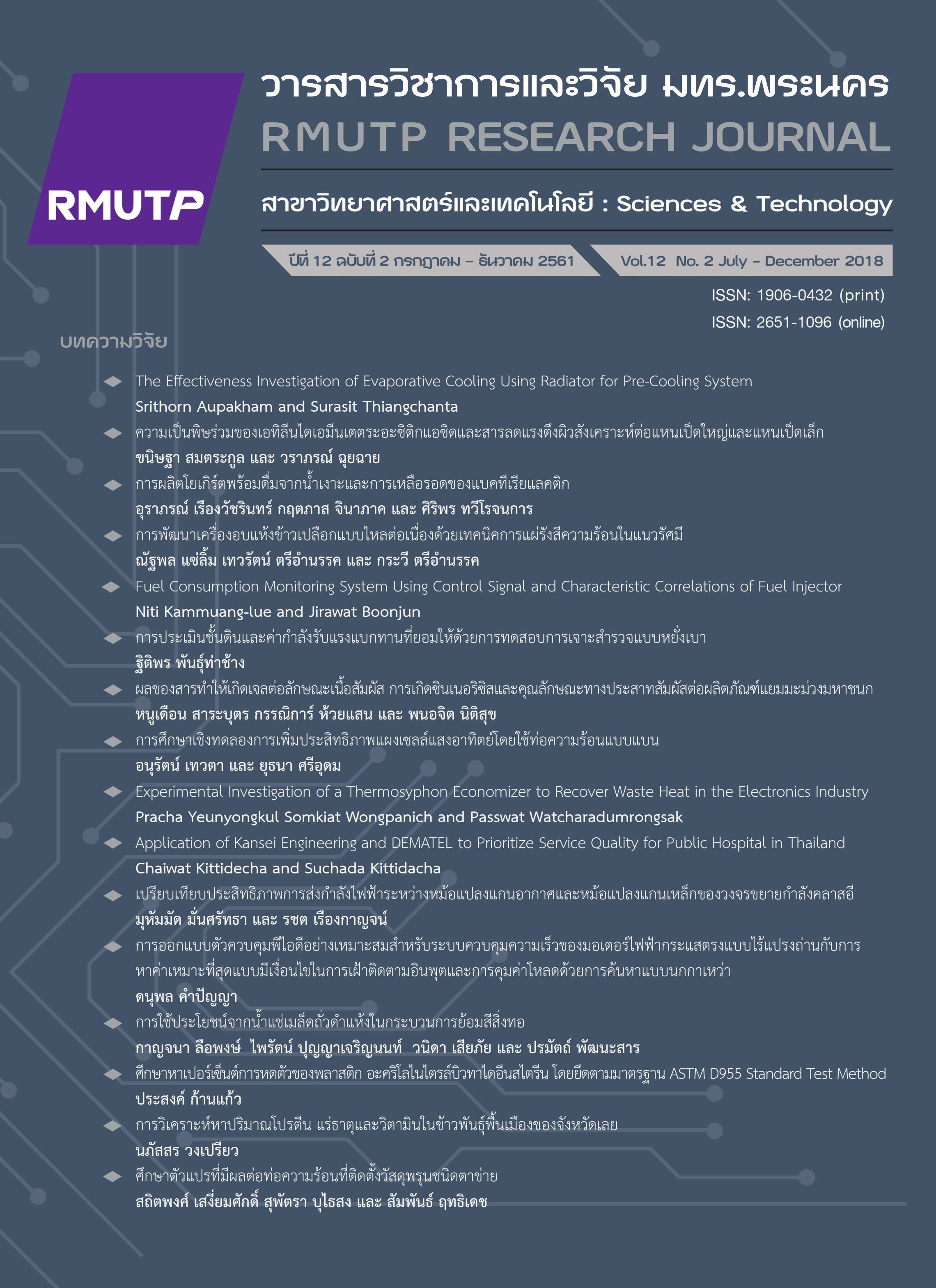นมเปรี้ยวพร้อมดื่มจากน้ำเงาะและการเหลือรอดของแบคทีเรียแลคติก
Main Article Content
บทคัดย่อ
งานวิจัยนี้มีวัตถุประสงค์เพื่อศึกษาปริมาณน้ำเงาะเข้มข้นที่เหมาะสมในการผลิตนมเปรี้ยว โดยใช้น้ำเงาะเข้มข้นในสัดส่วน ร้อยละ 0, 10, 15, 20 และ 25 โดยน้ำหนัก และทำการประเมินคุณภาพทางด้านกายภาพ เคมี จุลินทรีย์ และการประเมินทางประสาทสัมผัส การเหลือรอดของแบคทีเรียแลคติก และการศึกษาปริมาณสารให้ความหวาน จากการศึกษาพบว่าสัดส่วนของน้ำเงาะเข้มข้นที่เพิ่มขึ้น ไม่ส่งผลต่อการเปลี่ยนแปลงค่าสี L*, a* ในขณะที่ค่า b* และค่าความหนืดจะเพิ่มขึ้นอย่างมีนัยสำคัญทางสถิติ (p<0.05) เมื่อมีปริมาณของน้ำเงาะเพิ่มขึ้น อัตราส่วน โยเกิร์ต: น้ำเงาะเข้มข้น 85: 15 มีอัตราการรอดชีวิตของแบคทีเรียแลคติกร้อยละ 88 หลังผ่านระบบทางเดินอาหารจำลอง ศึกษาอัตราส่วนสารให้ความหวานที่เหมาะสมในการผลิตนมเปรี้ยวพร้อมดื่ม (โยเกิร์ต: น้ำเงาะเข้มข้น 85 : 15) เติมสารให้ความหวานร้อยละ 10 โดยน้ำหนัก ได้รับคะแนนการยอมรับทางประสาทสัมผัสสูงสุด ศึกษาอายุการเก็บรักษาผลิตภัณฑ์นมเปรี้ยวพร้อมดื่มที่เก็บรักษาไว้ในตู้เย็นที่อุณหภูมิ 4±1 องศาเซลเซียส เป็นเวลา 15 วัน พบว่า จํานวนการเหลือรอดของแบคทีเรียแลคติก เท่ากับ 9.90 ล็อคโคโลนีต่อกรัม
Article Details
เอกสารอ้างอิง
[2] H. Cormier, E. Thifault, V. Garneau, A. Tremblay, V. Drapeau and L. Perusse, “Association between yogurt consumption, dietary patterns, and cardio-metabolic risk factors,”European Journal of Nutrition, vol 55, pp. 577-587, 2015.
[3] R. Fuller “Probiotics in man and animals,”Journal of Applied Bacteriology, vol. 66, pp. 365-378, 1989.
[4] Notification of the Ministry of Public Health. Use of Probiotic Microorganisms in Foods. Published in the Government Gazette Vol. 128, Special Part 86 Ngor, August 2011.
[5] Siam business, Section: Marketing-CSR, vol. 19 (1385), pp. 22, 13-15 March. 2013.
[6] M. B. Akin, M. S. Akin, and Z. Kirmaci, “Effects of inulin and sugar levels on the viability of yogurt and probiotic bacteria and the physical and sensory characteristics in probiotic ice cream,”
Food Chem, vol. 104, pp. 93–99, 2007.
[7] A. Homayouni, M. R. Ehsani, A. Azizi, S. H. Razavi and M. S. Yarmand, “Growth and survival of some probiotic strains in simulated ice cream condition,” Journal of Applied Sciences, vol. 8, pp. 379 -382, 2008.
[8] G. R. Gibson, and M. B. Roberfroid, “Dietary modulation of the human colonic microbiota: introducing the concept of prebiotics,” Journal of Nutrition, vol. 125, pp. 1401-1412, 1995.
[9] G. R. Gibson, “Prebiotics,” Journal of Gastroenterology, Suppl. vol. 18, pp. 251-257, 2004.
[10] S. Kolida, K. Tuohy and G. R. Gibson, “Prebiotic effect of inulin and oligofructose,” British Journal of Nutrition, vol. 87, pp. S193-S197, 2002.
[11] G. K. Gbassi, T. Vandamme, S. Ennahar, and E. Marchioni, “Microencapsulation of Lactobacillus plantarum spp. in an alginate matrix coated with whey proteins,” Inter Journal of Food Microbioogy, vol. 129(1), pp. 103-105, Jan. 2009.
[12] S. Srisuk, “Job’s Tears Drinking Yoghurt Development,” YRU Journal of Science and Technology, Vol. 1 (2), pp. 53-64, Jul – Dec. 2016.
[13] C. Kongphoothorn, “Development of soymilk yoghurt with lactic acid bacteria,” Faculty of Agro-Industry, Department of Biotechnology, Kasetsart University, 2005.
[14] J. Maneerat, “Comparison of qualities of pineapple flavored yoghurt production from mixtured of goats’ and cows’ milk,”
Faculty of Agricultural Technology, Rajamangala University of Technology Thanyaburi. 2010.
[15] S. M. Mazloomi, S. S. Shekarforoush, H. Ebrahimnejad and J. Sajedianfard, “Effect of adding inulin on microbial and physicochemical properties of low fat probiotic yogurt,” Iranian Journal of Veterinary Research, vol. 12 (2), pp. 93-97, 2011.
[16] N. J. Gonzalez, K. Adhikari and M. F. “Sancho-MadrizSensory characteristics of peach-flavored yogurt drinks containing prebiotics and synbiotics,” LWT - Food Science and Technology, vol. 44(1), pp. 158-163, 2011.
[17] P. F. Fox and P. L. H. McSweeney, “Dairy chemistry and biochemistry,” Kluwer Academic/Plenum Publishers: New York. 1998.
[18] S. Wichienchot, P. Thammarutwasik, A. Jongjareonrak, W. Chansuwan, P. Hmadhlu, T. Hongpattarakere, A. Itharat and B. Ooraikul, “Extraction and analysis of prebiotics from selected plants from southern Thailand” Songklanakarin Journal of Science and Technology, vol. 33 (5), pp. 517-523, 2011.
[19] J. Matto, H.-L. Alakomi, A., Vaari, I. Virkajarvi and M. Saarela, “Influence of processing conditions on Bifidobacterium animalis subsp. lactis functionality with a special focus on acid tolerance and factors affecting it,” International Dairy Journal, vol. 16(9), pp. 1029-1037, 2006.
[20] R. Bedani, A. D. S Viera, E.A. Rossi and S. M. I. Saad, “Tropical fruit pulps decressed probiotic survival to in vitro gastrointestinal stress in symbiotic soy yoghurt with okara during storage,” LWT-Food Science and Technology, vol. 55 pp. 436-443, 2014.
[21] A. Chaikulsareewath, “Production of Drinking Yogurt Fortified with Gac Fruit,” Journal of Food Science and Technology, Siam University, vol.7(1), pp. 23-30. May-June, 2010.
[22] T. Vatakit1 and B. Leenanon, “Survival of Lactic Acid Bacteria in Mangosteen Soghurt Product,” KKU Research Journal, vol. 16(5), pp. 468-477, 2012.


